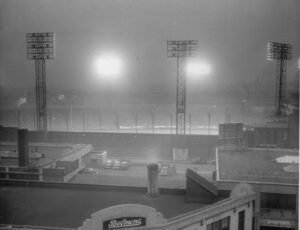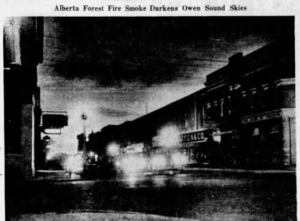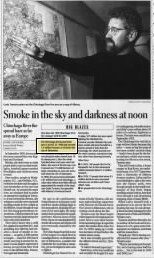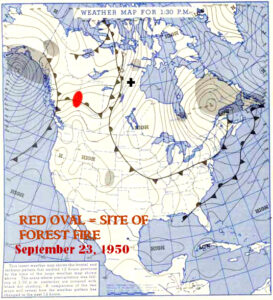
 During the summer and early fall of 1950, a series of fires in northern Alberta and northeastern British Columbia consumed around 4 million acres, making it the largest recorded fire in North American history. This event was known as the Chinchaga fire, and it generated smoke that ascended into Earth’s upper atmosphere and covered parts of Canada and the United States by late September, leading to the phenomenon known as the Great Smoke Pall. The dense, black smoke caused midday skies to darken, prompting some to speculate about a nuclear attack. Phone calls started coming in as the people panicked. The impact of the Great Smoke Pall extended as far as Europe.
During the summer and early fall of 1950, a series of fires in northern Alberta and northeastern British Columbia consumed around 4 million acres, making it the largest recorded fire in North American history. This event was known as the Chinchaga fire, and it generated smoke that ascended into Earth’s upper atmosphere and covered parts of Canada and the United States by late September, leading to the phenomenon known as the Great Smoke Pall. The dense, black smoke caused midday skies to darken, prompting some to speculate about a nuclear attack. Phone calls started coming in as the people panicked. The impact of the Great Smoke Pall extended as far as Europe.
The Chinchaga fire, also referred to as “Fire 19” or the Wisp fire, it is believed to have been started by humans near Fort Saint John in Alberta, Canada. During an unusually hot and dry spring, the fire ignited on June 1, 1950, but received little attention from the media. A policy had been put in place to ignore fires in remote areas, much like the “Let it Burn” policy of the 1970s, so authorities allowed it to burn freely. The fire grew into a massive inferno, raging all summer and spreading further with the changing winds and weather fronts.
In September 1950, winds intensified the flames, leading to a significant expansion of the fire. Thick smoke ascended into the atmosphere, encountered an atmospheric trough, and shrouded Ontario before moving towards Ohio and the eastern coast of the United States. On September 24th, the residents of Ontario observed strange hues in the sky. By midday, the smoke had obscured the sunlight, necessitating the activation of streetlights. The whole area took on an eerie tone.
That afternoon, smoke spread along the eastern seaboard. Pilots landing at New York City’s LaGuardia Airport faced zero visibility, necessitating instrument landings. By 4:00 pm, Pennsylvania residents observed unusual colors in the sky, which darkened completely within half an hour. The smoke was so elevated in the atmosphere 
 that it was odorless, and it sparked fears of a nuclear attack among some. Others speculated that an anticipated total lunar eclipse had prematurely begun. Reports of a purple moon abounded, and panic ensued as numerous people feared an apocalyptic event.
that it was odorless, and it sparked fears of a nuclear attack among some. Others speculated that an anticipated total lunar eclipse had prematurely begun. Reports of a purple moon abounded, and panic ensued as numerous people feared an apocalyptic event.
The smoke spread to Western Europe, where high-altitude smoke particles caused the sun to appear blue, intensifying fears of a nuclear attack. By late October 1950, rains and cooler temperatures ultimately put out the fire. The widespread panic induced by the Chinchaga fire prompted the Canadian Forest Service to implement new fire suppression techniques to avert a recurrence. All thoughts of a “Let it Burn” type policy were abandoned…for the time being anyway.


Leave a Reply